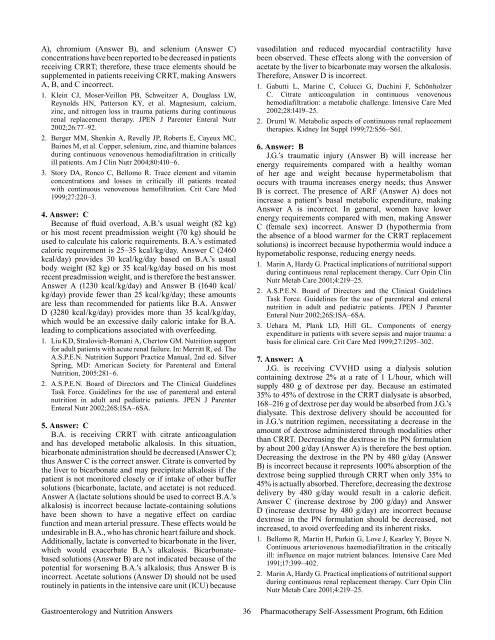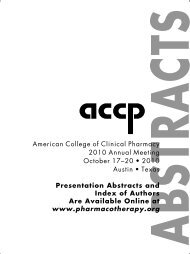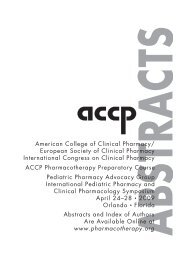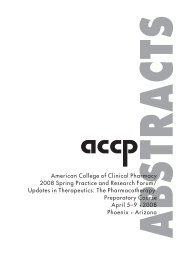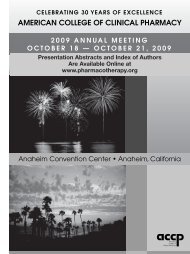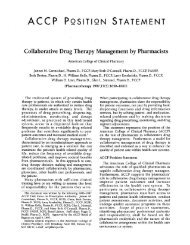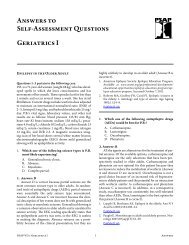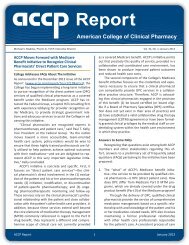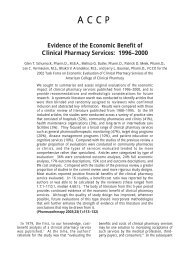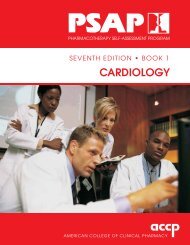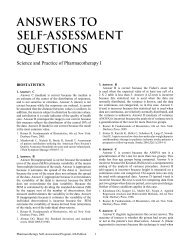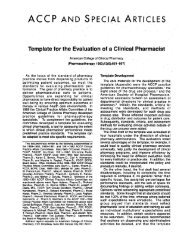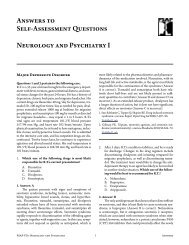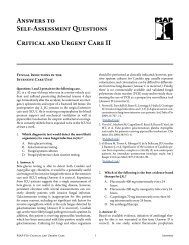Answers to Self-Assessment Questions - ACCP
Answers to Self-Assessment Questions - ACCP
Answers to Self-Assessment Questions - ACCP
You also want an ePaper? Increase the reach of your titles
YUMPU automatically turns print PDFs into web optimized ePapers that Google loves.
A), chromium (Answer B), and selenium (Answer C)<br />
concentrations have been reported <strong>to</strong> be decreased in patients<br />
receiving CRRT; therefore, these trace elements should be<br />
supplemented in patients receiving CRRT, making <strong>Answers</strong><br />
A, B, and C incorrect.<br />
1. Klein CJ, Moser-Veillon PB, Schweitzer A, Douglass LW,<br />
Reynolds HN, Patterson KY, et al. Magnesium, calcium,<br />
zinc, and nitrogen loss in trauma patients during continuous<br />
renal replacement therapy. JPEN J Parenter Enteral Nutr<br />
2002;26:77–92.<br />
2. Berger MM, Shenkin A, Revelly JP, Roberts E, Cayeux MC,<br />
Baines M, et al. Copper, selenium, zinc, and thiamine balances<br />
during continuous venovenous hemodiafiltration in critically<br />
ill patients. Am J Clin Nutr 2004;80:410–6.<br />
3. S<strong>to</strong>ry DA, Ronco C, Bellomo R. Trace element and vitamin<br />
concentrations and losses in critically ill patients treated<br />
with continuous venovenous hemofiltration. Crit Care Med<br />
1999;27:220–3.<br />
4. Answer: C<br />
Because of fluid overload, A.B.’s usual weight (82 kg)<br />
or his most recent preadmission weight (70 kg) should be<br />
used <strong>to</strong> calculate his caloric requirements. B.A.’s estimated<br />
caloric requirement is 25–35 kcal/kg/day. Answer C (2460<br />
kcal/day) provides 30 kcal/kg/day based on B.A.’s usual<br />
body weight (82 kg) or 35 kcal/kg/day based on his most<br />
recent preadmission weight, and is therefore the best answer.<br />
Answer A (1230 kcal/kg/day) and Answer B (1640 kcal/<br />
kg/day) provide fewer than 25 kcal/kg/day; these amounts<br />
are less than recommended for patients like B.A. Answer<br />
D (3280 kcal/kg/day) provides more than 35 kcal/kg/day,<br />
which would be an excessive daily caloric intake for B.A.<br />
leading <strong>to</strong> complications associated with overfeeding.<br />
1. Liu KD, Stralovich-Romani A, Cher<strong>to</strong>w GM. Nutrition support<br />
for adult patients with acute renal failure. In: Merritt R, ed. The<br />
A.S.P.E.N. Nutrition Support Practice Manual, 2nd ed. Silver<br />
Spring, MD: American Society for Parenteral and Enteral<br />
Nutrition, 2005:281–6.<br />
2. A.S.P.E.N. Board of Direc<strong>to</strong>rs and The Clinical Guidelines<br />
Task Force. Guidelines for the use of parenteral and enteral<br />
nutrition in adult and pediatric patients. JPEN J Parenter<br />
Enteral Nutr 2002;26S:1SA–6SA.<br />
5. Answer: C<br />
B.A. is receiving CRRT with citrate anticoagulation<br />
and has developed metabolic alkalosis. In this situation,<br />
bicarbonate administration should be decreased (Answer C);<br />
thus Answer C is the correct answer. Citrate is converted by<br />
the liver <strong>to</strong> bicarbonate and may precipitate alkalosis if the<br />
patient is not moni<strong>to</strong>red closely or if intake of other buffer<br />
solutions (bicarbonate, lactate, and acetate) is not reduced.<br />
Answer A (lactate solutions should be used <strong>to</strong> correct B.A.’s<br />
alkalosis) is incorrect because lactate-containing solutions<br />
have been shown <strong>to</strong> have a negative effect on cardiac<br />
function and mean arterial pressure. These effects would be<br />
undesirable in B.A., who has chronic heart failure and shock.<br />
Additionally, lactate is converted <strong>to</strong> bicarbonate in the liver,<br />
which would exacerbate B.A.’s alkalosis. Bicarbonatebased<br />
solutions (Answer B) are not indicated because of the<br />
potential for worsening B.A.’s alkalosis; thus Answer B is<br />
incorrect. Acetate solutions (Answer D) should not be used<br />
routinely in patients in the intensive care unit (ICU) because<br />
Gastroenterology and Nutrition <strong>Answers</strong><br />
36<br />
vasodilation and reduced myocardial contractility have<br />
been observed. These effects along with the conversion of<br />
acetate by the liver <strong>to</strong> bicarbonate may worsen the alkalosis.<br />
Therefore, Answer D is incorrect.<br />
1. Gabutti L, Marine C, Colucci G, Duchini F, Schönholzer<br />
C. Citrate anticoagulation in continuous venovenous<br />
hemodiafiltration: a metabolic challenge. Intensive Care Med<br />
2002;28:1419–25.<br />
2. Druml W. Metabolic aspects of continuous renal replacement<br />
therapies. Kidney Int Suppl 1999;72:S56–S61.<br />
6. Answer: B<br />
J.G.’s traumatic injury (Answer B) will increase her<br />
energy requirements compared with a healthy woman<br />
of her age and weight because hypermetabolism that<br />
occurs with trauma increases energy needs; thus Answer<br />
B is correct. The presence of ARF (Answer A) does not<br />
increase a patient’s basal metabolic expenditure, making<br />
Answer A is incorrect. In general, women have lower<br />
energy requirements compared with men, making Answer<br />
C (female sex) incorrect. Answer D (hypothermia from<br />
the absence of a blood warmer for the CRRT replacement<br />
solutions) is incorrect because hypothermia would induce a<br />
hypometabolic response, reducing energy needs.<br />
1. Marin A, Hardy G. Practical implications of nutritional support<br />
during continuous renal replacement therapy. Curr Opin Clin<br />
Nutr Metab Care 2001;4:219–25.<br />
2. A.S.P.E.N. Board of Direc<strong>to</strong>rs and the Clinical Guidelines<br />
Task Force. Guidelines for the use of parenteral and enteral<br />
nutrition in adult and pediatric patients. JPEN J Parenter<br />
Enteral Nutr 2002;26S:1SA–6SA.<br />
3. Uehara M, Plank LD, Hill GL. Components of energy<br />
expenditure in patients with severe sepsis and major trauma: a<br />
basis for clinical care. Crit Care Med 1999;27:1295–302.<br />
7. Answer: A<br />
J.G. is receiving CVVHD using a dialysis solution<br />
containing dextrose 2% at a rate of 1 L/hour, which will<br />
supply 480 g of dextrose per day. Because an estimated<br />
35% <strong>to</strong> 45% of dextrose in the CRRT dialysate is absorbed,<br />
168–216 g of dextrose per day would be absorbed from J.G.’s<br />
dialysate. This dextrose delivery should be accounted for<br />
in J.G.’s nutrition regimen, necessitating a decrease in the<br />
amount of dextrose administered through modalities other<br />
than CRRT. Decreasing the dextrose in the PN formulation<br />
by about 200 g/day (Answer A) is therefore the best option.<br />
Decreasing the dextrose in the PN by 480 g/day (Answer<br />
B) is incorrect because it represents 100% absorption of the<br />
dextrose being supplied through CRRT when only 35% <strong>to</strong><br />
45% is actually absorbed. Therefore, decreasing the dextrose<br />
delivery by 480 g/day would result in a caloric deficit.<br />
Answer C (increase dextrose by 200 g/day) and Answer<br />
D (increase dextrose by 480 g/day) are incorrect because<br />
dextrose in the PN formulation should be decreased, not<br />
increased, <strong>to</strong> avoid overfeeding and its inherent risks.<br />
1. Bellomo R, Martin H, Parkin G, Love J, Kearley Y, Boyce N.<br />
Continuous arteriovenous haemodiafiltration in the critically<br />
ill: influence on major nutrient balances. Intensive Care Med<br />
1991;17:399–402.<br />
2. Marin A, Hardy G. Practical implications of nutritional support<br />
during continuous renal replacement therapy. Curr Opin Clin<br />
Nutr Metab Care 2001;4:219–25.<br />
Pharmacotherapy <strong>Self</strong>-<strong>Assessment</strong> Program, 6th Edition


